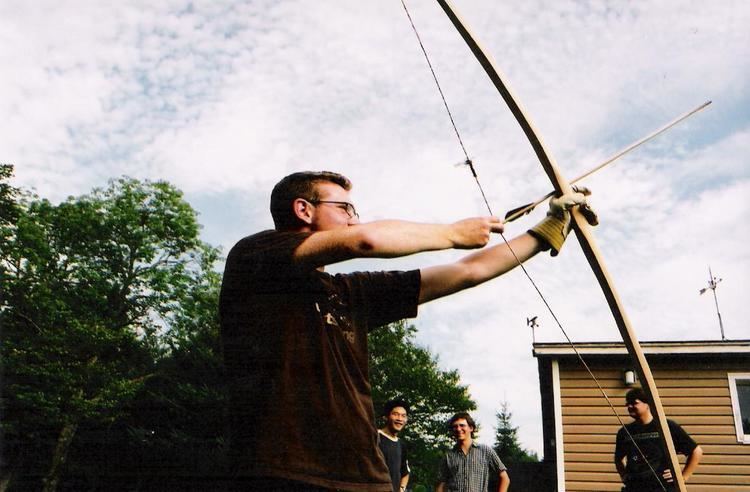 | ||
A flatbow is a bow with non-recurved, flat, relatively wide limbs that are approximately rectangular in cross-section. Because the limbs are relatively wide, flatbows will usually narrow and become deeper at the handle, with a rounded, non-bending handle for easier grip. This design differs from that of a longbow, which has rounded limbs that are circular or D shaped in cross-section, and is usually widest at the handle. A flatbow can be just as long as a longbow, but can be very short. (Typical lengths would be 68-70" for a flatbow, 70-72" for an English longbow, and 72-76" for a warbow-weight English longbow; but these styles may easily overlap each other.) Traditional flatbows are usually wooden self bows (bows made of one solid piece of wood), though laminated and composite flatbows have been made in ancient and modern times. Modern flatbows commonly use fiberglass.
Contents
Advantages of a rectangular cross-section
The flatbow is a superior bow design for almost all materials because the stress is more evenly spread out than with rounded limb sections. A bow limb is essentially a flexed beam undergoing bending, and in any flexed beam the farther from the neutral axis (line in the middle of the flexing beam which is not under tension or compression: see diagram in Bending article) the more stress there is within the material. When a limb is rounded, as in a longbow, some material sticks out farther from the neutral axis, and thus is put under greater stress. In a flatbow, the flat belly and back ensure that all of the most strained material is a uniform distance from the neutral axis, spreading the load over a wider limb, minimizing stress and making weaker woods far less likely to fail (break or become permanently bent and lose the resilience needed in a bow). Only particularly resilient timbers can make an effective and powerful wooden longbow.
Suitable timbers
In most parts of the world, common hardwoods may be used to create excellent bows. Suitable and easily available timbers include elm (used in ancient Europe, as evidenced by bows pulled from European bogs), maple, sycamore, hazel, and ash. The flatbow design also lends itself to very dense, high strength woods such as hickory and especially osage orange (a wood favored by many Native American tribes for bow making). Good quality yew wood is still much more expensive and difficult to find than woods suitable for flatbows, and beginning bowyers are strongly recommended to start with a flatbow made from easily available wood. Because yew, the wood of choice for European longbows, is light, resilient, and has exceptional compressive strength, the rounded design can be used to produce a smooth shooting, efficient, powerful bow. This is economical of wood and of the bowyer's time.
Disadvantages of a rectangular cross-section
Compared to a narrow, rounded longbow design, the bowyer needs to start with a wider stave, take more time to achieve an approximately rectangular cross-section, and may need to cut through growth rings on the back of the bow.
Historic use
Flatbows were used by Native American tribes such as the Hupa, Karok, and Wampanoag, prehistoric ancient Europeans, some Inuit tribes, Finno-Ugric nations and a number of other pre-gunpowder societies for hunting and warfare because, unlike longbows, good flatbows can be made from a wide variety of timbers. Flatbows fell from favour in Europe after the Mesolithic, replaced with yew longbows. The trade of yew wood for English longbows was such that it depleted the stocks of yew over a huge area. Flatbows are currently used by the paleolithic Sentinelese tribes of the Andaman Islands. Flatbows survived in cold areas, such as Finland, where yew does not grow naturally because of the unsuitable climate. The traditional Finnish flatbow is made either from ash, or as birch/pine laminate glued together with fish or hide glue. Yew was available as an imported material for bows in Finland, but it was considered not suitable for serious use, because it is fragile at cold temperatures and the season for hunting for furs is in January and February, when the furs are at their best.
American flatbow
The American flatbow, also known as the American longbow, was developed in the 1930s. It resulted from scientific investigation into the best cross-sectional shape for a bow limb. This research was expected to explain why the English longbow's D-section was superior to all other extant designs. Instead, it showed that the best cross-section was a simple rectangle. The American Flatbow was developed by applying these research findings to the English longbow. The result was a more efficient and stable bow which can be made from more common woods. Because of its coincidental resemblance to some Native American bows, the American flatbow is also known as the semi-Indian bow.
The American flatbow was popularised by Howard Hill and quickly displaced the English longbow as the preferred bow for target shooting. The modern Olympic-style recurve bow is a development of the American flatbow, usually using fiberglass rather than wood for the backing and belly of the recurved limbs, artificial materials such as carbon for the core, and with a built-up riser (handle) section (often made of metal, but other materials such as wood or phenolic resin have been used). The tips are flexible rather than static.
